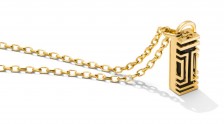Article: What Hunting For A Mate Teaches You About Great Design
By Ayça Çakmakli for Co.Design.
If some of these ideas seem familiar, you’re right: what you look for in a partner is also what you want in a product, argues smart design’s Ayça Çakmakli.
Companies sometimes miss the opportunity to really click with their customers. Although they often make very sensible choices of features and functions, they can fail to create products and services that have a real personality. It’s this personality that makes the first connection with customers and ultimately long-lasting relationships with brands.
Designers have always understood the power of personification. Car designers have been manipulating the facelike front end of cars for generations. Ceramicist Eva Zeisel used a bellybutton-like indentation in a pair of vessels to evoke the connection between mother and child. It’s a simple design detail that inspires a strong emotional response. What’s interesting is how attuned the mind can be to subtle aesthetic nuances in human form. But the connection goes far deeper than the physical; it’s about how a product or service behaves and what it delivers over time. As is the case with people, it’s what’s inside that counts.
To better understand the attributes of a product or service that matter most to people, I studied the traits we look for in an ideal mate or long-term partner. I combed through scientific studies from the fields of sociology, anthropology, and psychology, bubbling up seven universal traits that most of us look for in a mate. Then, using my experience as a design researcher, I mapped these traits directly to people’s experiences with brands, products, and services:
1. SOCIAL STATUS

We are often drawn to partners that project the type of lifestyle to which we aspire. Brands understand this desire; they create elaborate worlds for us to be a part of. For instance, there is truth in the saying, You are what you drive. A Prius owner predictably has a different set of values than someone who drives a Mercedes. So if it turns out a brand doesn’t align with your core values, the relationship will inevitably fail. That’s the difference between a short-term and long-term relationship.
2. ATTRACTIVENESS

We are drawn to potential partners we consider to be beautiful. The same goes for objects. It’s what motivates us to want to know a product better. The attractiveness of pure forms by designers such as Dieter Rams and Naoto Fukasawa reinforce the idea that universal beauty does exist. But it’s important to keep in mind that context plays an important role in defining beauty as well. For instance, when Smart Design created a new watering can for OXO, we reasoned that a cuter aesthetic matched the activity it would be used for: taking care of flowers.
3. TRUSTWORTHINESS

We need partners we can rely on. Trust is manifested in how well a product lives up to its brand promise. If expectations are met, a user begins to form an emotional bond with it. American Express is one of these brands. Users consistently praise the AmEx experience. A friend once said, “AmEx always has my back.” So trust is a trait that shouldn’t be tested. Just as when trust is violated in a relationship, the repercussions for brands can be extreme.
4. INTELLIGENCE

Status, looks, and trust can go a long way, but humans crave intellectual stimulation, too. Intelligence in design is measured according to how well a product functions. Is it intuitive to use and adaptable? Does it educate the user? True product intelligence focuses on an enjoyable experience that can adapt to users’ habits and needs. Amazon.com was one of the earliest to design an intellectually rewarding online experience. The site prioritizes the information most important to us and offers product suggestions based on our buying patterns. It’s an experience that is intelligent enough to distinguish between what we care about and what we don’t.
5. EMPATHY

Now we’re getting pretty close to the perfect mate. They share our values. They’re good-looking. They keep their promises, and they’re smart. But what happens if they just don’t get us? The relationship isn’t going to last. What we need is empathy. One of the most important things in a relationship is having a partner who’s able to understand you. Empathy can come in many forms, including compassion, understanding, and communication. We desire empathetic products as well. How many times have you used a product and wished you were taller, stronger, or had bigger hands? That’s because in design, empathy can be manifested in ergonomics. The more a product understands you and anticipates your needs, the more relevant it becomes in your life.
6. EXCITEMENT

Excitement and surprises are what bring spice to our relationships. No wonder “sense of humor” is on 99% of online dating profiles. The element of excitement is something that we look for in products and brands, too. It keeps us interested over the long term. To many of my friends, Under Armor is an exciting brand because it turns a simple T-shirt into a temperature-regulating, sweat-wicking, blood-circulating, muscle-compressing machine. Under Armor doesn’t just design clothes–it creates performance tools that give your workout an adrenaline rush. That’s how the brand inspires a loyal following of the most passionate athletes.
7. AMBITION

It looks like we have almost everything, but we still need ambition to keep the future looking bright. In the design world, ambition often reveals itself in the form of innovation. Innovative thinking brings a fresh take on what we already know and expect. It also inspires new experiences and new connections–sometimes before a new product has even launched. The amazing thing about Kickstarter is it creates buzz, buyers, and audiences for products that are sometimes still conceptual. Copies of books are sold before they are written. Concerts can sell out before the album has been recorded. It pushes designers to deliver when an audience has already bought in and creates loyal fans out of like-minded people who share the same vision.
MADE FOR EACH OTHER
Of course, as in any relationship, balance is key. There is no checklist or magic combination of traits that works for everyone. But what I learned is consumers expect more than just a hot product. We want products and experiences that don’t fail when we need them most and make us feel good about ourselves. As if being matched with an ideal mate, we all want to fall in love and live happily ever after.
But understanding people is no easy task. Even though we’ve been interacting with each other far longer than we’ve been interacting with products, there is always more learning to be done and applied. When companies let go of the idea that they are selling individual objects, they can start designing for living, growing relationships that exist within our society. When that happens, the relationships we have with products–and with each other–will only grow stronger.
Originally posted on Fast Company.
Ayça Çakmakli / Design Researcher / ayça.çakmakli@smartdesignworldwide.com





